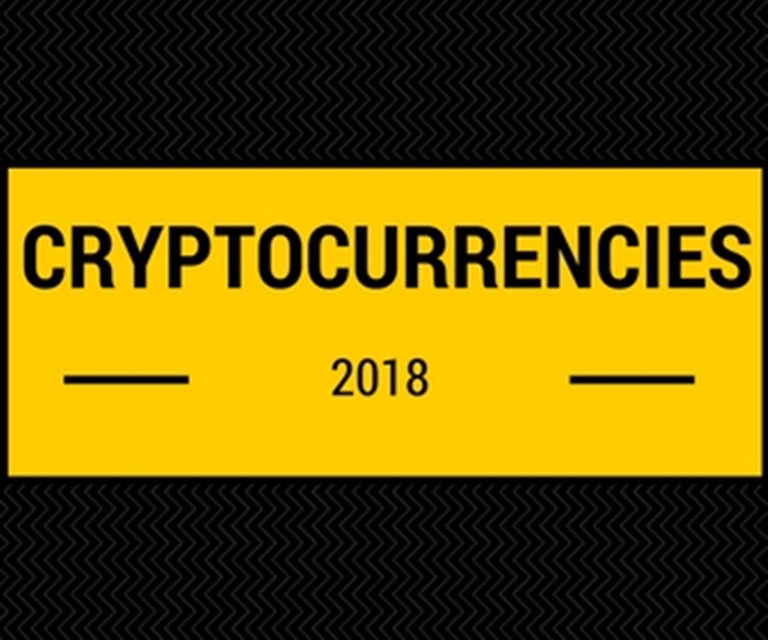11 Cryptocurrencies You Need to Know about for 2018

As 2017 comes to a close cryptocurrencies are all the rage among aggressive investors. As more and more people become aware of cryptocurrencies (which have actually seen very minimal investment in terms of the overall economy, despite a $500 billion market cap), the space is ready to explode in 2018. Strangely enough, 2017 has been called the year of Bitcoin, with the leading digital currency rising roughly 1,600% since the start of the year, but that may be dwarfed by the performance of the entire cryptocurrency space in 2018. If 2017 was the year of Bitcoin, 2018 may be known as the year of crypocurrencies. Below are 11 of the top cryptocurrencies as this year comes to an end, making them good choices for investment as we head into 2018.
Bitcoin (BTC)

Bitcoin gets the first spot on the list because it is the oldest, and by far the largest cryptocurrency. With first mover advantage, and its use as an exchange medium for most other cryptocurrencies, it is likely to remain the leader in 2018. The recent introduction of futures trading in Bitcoin has sparked the cryptocurrency revolution for the mainstream, and if some very smart people are to be believed we could see Bitcoin trading as high as $100,000 in 2018. Mining for Bitcoin will continue to grow in popularity, and the largest U.S. exchange for Bitcoin, Coinbase, should see its user base grow well beyond the current 13 million accounts. While many have called Bitcoin a currency, it is becoming apparent that it is actually more a store of value, and that as its price, and transaction fees, continue growing, people are more likely to use Bitcoin for saving and increasing wealth rather than spending.
Litecoin (LTC)

Litecoin was based on the Bitcoin model, and was created in 2011 by former Google engineer Charlie Lee. While Mr. Lee stepped back from the project for several years, he has recently become more active once again, and has been a major proponent for Litecoin and its usage, even appearing in mainstream publications and television, including an appearance recently on CNBC’s Squawk Box. He is also very active on Twitter, where he has 334k followers and goes by the handle @SatoshiLite. Litecoin is a likely contender for use as an actual transactional coin, thanks to its improved transaction speed and lower transaction costs when compared with Bitcoin. Given the recent run-up in Litecoin’s price, mining for Litecoin is likely to explode as well.
Ethereum (ETH)

While many call the coin Ethereum, this is actually the name of the blockchain network, and the actual ETH coin is called Ether. It is currently the second largest cryptocurrency by market cap, with a total value of $66 billion. The Ether coin is used as a transfer of value among public nodes and accounts, and its usage is most notable as the basis for many of the new coins being created and offered in initial coin offerings (ICOs). It is a decentralized platform, which is capable of running smart contracts and applications that run exactly as programmed without any possibility of downtime, censorship, fraud or third-party interference. Ethereum is fairly new, having come into existence on July 30, 2015. Like Litecoin, it has a vocal creator in the form of Vitalik Buterin, who first proposed the Ethereum network in 2013, and is responsible for creating the eventual Ethereum network and Ether coin. Mining Ethereum is still possible, but it has fallen in favor as the coin is supposed to move from proof-of-work to proof-of-stake sometime in 2018, which would make mining the coin impossible.
Ripple (XRP)

Ripple was created as a real-time gross settlement system for use in banking and business. It enables nearly instantaneous and low-cost international transfers and is meant as a replacement for the current slow and expensive SWIFT system used in traditional banking and business. Because it has a circulating supply of more than 37 billion coins, with a maximum of 100 billion coins eventually being created, the price of Ripple has remained quite low, ranging between $0.20 and $0.24 for most of 2017, although the past days have seen Ripple surge to an all-time high of $0.46 per coin.
Monero (XMR)

Monero appeared on the scene in April 2014 and has grown rapidly since then due to the high level of privacy it affords its users. While every transaction is stored on the blockchain, they can also be obfuscated in such a way that it is impossible to know who was the sender or receiver of any given transaction, as well as being impossible to know the value of any transaction. The developers of Monero refer to this as “selective transparency” as each user can decide on a per transaction basis who can and cannot check their transaction information. This high level of privacy has attracted users to Monero and it rapidly became one of the most mined cryptocurrencies.
DASH (DASH)

At DASH’s core is a unique fully-incentivized peer-to-peer network. Miners are rewarded for securing the blockchain and masternodes are rewarded for validating, storing and serving the blockchain to users. In this respect it is little different to Bitcoin. There are differences to DASH however, such as additional security and anonymity baked into the transactions. Transactions made with Dash are private, secure and untraceable. Transactions are nearly instantaneous, and fees are extremely low, in some cases non-existent. It was originally launched in January 2014 as XCoin, was rebranded DarkCoin the following month, and in March 2015 was finally rebranded to DASH, which is a portmanteau for “Digital Cash”.
EOS (EOS)

The EOS coin was developed by Dan Larimer, and is his third foray into cryptocurrencies as he was also the developer behind Bitshares and the Steemit project. Unlike most cryptocurrencies, EOS is built on a proof of stake system, meaning there is no mining. Instead those who hold EOS coins receive periodic payments of more EOS coins. Kind of like a dividend for holding the coin and securing the network. It also features 10,000+ transactions per second, as well as parallel processing for those who launch DAPPS on the EOS network. Finally, EOS is able to communicate with other blockchains, which is a notable achievement, though one that is underutilized so far. EOS is quite new, with the genesis block coming on July 1, 2017 and it’s price has gone from $2.00 at that time to $7.80 as of the writing of this article.
NEO (NEO)

NEO is a play on Chinese adoption of cryptocurrencies, and is called by some the Ethereum of China. It has been suggested that if the Chinese government were to ease its posture regarding ICOs and cryptocurrencies, NEO stands to explode in value. It’s already up nearly 25,000% in 2017, so it’s hard to imagine an even better 2018 for NEO, which has already been around since 2014 and was launched as Antshares. NEO’s team has been busy in recent months spreading the gospel of their coin, and such marketing tactics certainly can’t hurt the value of NEO.
Bitcoin Cash (BCH)

Bitcoin Cash was created by a team of people who forked the bitcoin blockchain ledger. It is now controlled by multiple independent teams of developers. It is now one of the newest of the popular cryptocurrencies, having come into existence in August 2017 as part of a hard fork of Bitcoin. A hard fork is when a new blockchain is created that contains all the past information from the original coin, in this case Bitcoin, but going forward it operates separately from the original coin. Bitcoin Cash was created because some users were frustrated with the high fees and slow processing times of Bitcoin. There are even some who say Bitcoin Cash is the “real” Bitcoin, and thus the divide between Bitcoin and Bitcoin Cash continues. Who knows, if Bitcoin Cash can garner widespread adoption it could one day overtake Bitcoin as the top coin.
Stellar Lumens (XLM)

The Stellar Lumen is the coin used to avoid transaction spam in the Stellar network. It was created in 2014 with the symbol STR and called Stellar, but was renamed Lumens in March 2015 to avoid the confusion created by having the coin named the same as the network. At that time all holders of Bitcoin also received some Stellar Lumens coins. Many non-profits also received coins at that time as a sort of airdrop. There were 100 billion coins created at the time, which is quite huge in the cryptocurrency world. At the beginning of 2017 each Stellar Lumen was worth 0.0025, but as of this writing they are worth 0.1478 each. Stellar has recently partnered with IBM to enable cross-border payments, which gave the coin price a definite boost.
IOTA (IOT)

IOTA is unique in that it is the first cryptocurrency that hasn’t been developed using blockchain technology. Instead it uses a different distributed ledger architecture called “Tangle”. This new and unique architecture has allowed IOTA to already achieve three major milestones in the cryptocurrency world; zero-cost transactions, offline transactions, and infinite scalability. With no transaction fees and the ability to scale infinitely some are hailing IOTA as a replacement not only for Bitcoin, but for blockchain in general. IOTA also differs from other coins mentioned above in that it is concerned with providing machine-to-machine transactions, also known as the Internet of Things. IOTA’s developers contend that in the near future machines will handle many different kinds of transactions without any intervention from humans, and that a technology such as IOTA and the Tangle will allow them to do so. It remains to be seen whether or not they’re right, but several large corporations are backing IOTA and betting on the technology working well for business-to-business transactions.
This is just a very small selection of the number of coins available to traders, investors and technology adopters. The website CoinMarketCap.com currently shows 1353 cryptocurrencies and there are hundreds more that will launch in 2018. While these are the top coins right now, by the end of 2018 we could see other coins moving into the top 11, possibly even a coin that hasn’t yet been released or even created. This is part of the fun and excitement of the cryptocurrency world in these early days of discovery.
Resteemed by @resteembot! Good Luck!
The resteem was payed by @greetbot
Curious?
The @resteembot's introduction post
Get more from @resteembot with the #resteembotsentme initiative
Check out the great posts I already resteemed.
Don't forget about Steem!!
Oh I never forget about Steem ;)
And I figure no one reading this forgets about it either!
Thanks for this informative post. Glad to get some input on a few of these alt coins.
😄😇😄
